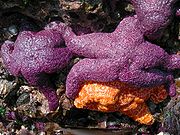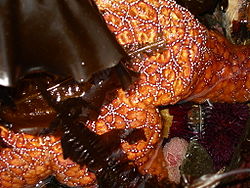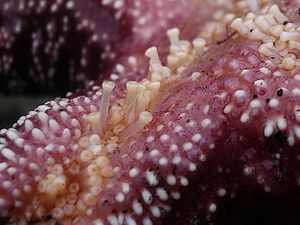Pisaster ochraceus
From ize2010
Pisaster ochraceus is generally known as the Purple Sea Star or Ochre Sea Star and is common along the Pacific coast.
| Ochre Star | |
|---|---|
 |
|
| Olympic Peninsula, Washington | |
| Scientific classification | |
| Kingdom: | Animalia |
| Phylum: | Echinodermata |
| Class: | Asteroidea |
| Order: | Forcipulata |
| Family: | Asteriidae |
| Genus: | Pisaster |
| Species: | ochraceus |
| Binomial name | |
| Pisaster ochraceus Brandt, 1835 |
|
Contents |
Description
Morphology
This sea star has five stout rays that range in length from 10 to 25 centimeters (4 to 10 in). The rays are arranged around an ill-defined central disk. While most individuals are purple, they can be orange, orange-ochre, and brown. The aboral surface contains many small spines (ossicles) that are arranged in a netlike or pentagonal pattern on the central disk. The ossicles are no higher than 2mm.[1] [2] In Pisaster the tube feet have suckers on their distal ends which allow them to attach to the rocky substrate and live in heavily wave-swept areas. [3]
Similar Species
Two species that can be mistaken as Pisaster ochraceus are Pisaster giganteus, which has blue rings around white or purple spines, and Pisaster brevispinus, which is pink with small white spines. These two species have different aboral spines and coloration which allows one to distinguish between the species. Evasterias troschelii may be confused with Pisaster ochraceus at times aswell. It can be distinguished from Pisaster ochraceus because Evasterias troschelii has a smaller disk size and longer, tapering rays which are often thickest a short distance out from the base rather than at the base as in Pisaster ochraceus.[2]
Reproduction and Life History
Reproduction
Pisaster are mainly dioecious but there is no sexual dimorphism and sexes can only be separated by the presence of eggs or sperm in the gonads. They reproduce by broadcast spawning, which occurs in the Puget Sound around May to July. [2] There is no parental investment beyond spawning. [4] Fertilization occurs in the water column and Pisaster ochraceous develops through several larval stages.[5]
The reproductive system consists of a pair of gonads branching into each ray off a circular genital strand which is along the oral inner surface of the central disc.[4] The gonads looks like a feathery collection of tubules. In females there are orange gonads and in males they are whitish..[3] During maturation of the gametes, the gonads increase in size and can account for up to 40 percent of the sea star's weight.[2] The gonopores are too small to be seen, and can only be found when the sea stars are spawning. [5] [2]
Lifespan
Many asteroids live to a minimal age or four to six years. The Pisaster ochraceous could live as long as twenty years. [4]
History
This species of seastar is often considered a keystone species in many intertidal regions. Pisaster ochraceus is an predator of the common mussel, Mytilus californicus and reduces its abundance. This allows for other macroinvertabrates to persist. In an experimental removal of the ochre star, it was shown that Mytilus californicus becomes almost completely dominant of the intertidal community. When Pisaster ochraceus is present there is a diverse intertidal community. [6]
Ecology and Distribution
Geographic Range
Pisaster ochraceus can be found from Prince William Sound in Alaska to Point Sal in Santa Barbara Co., California. Pisaster found within the warmer waters from Santa Barbara County to Baja, California is Pisaster ochraceus segnis, a subspecies of Pisaster ochraceus [7]
Habitat
This sea star can be found in great numbers on mussel beds and on wave-washed rocky shores. The juveniles are often found in crevices and under rocks.[5] Its depth range is from above the low-tide zone to 90 m in depth. Pisaster ochraceous is very durable and can tolerate a loss of thirty-percent of its body weight in body fluids.[4]
Trophic Strategy
At the larval stage, Pisaster ochraceus are filter feeders and their diet consists of plankton. As an adult, Pisaster ochraceous feeds on mussels like Mytilus californianus and Mytilus trossulus. They will feed on chitons, limpets, snails, barnacles, echinoids, and even decapod crustacea.[2] Pisaster ochraceous uses its tube feet to handle its prey. If the prey is too large to be swallowed whole, then it uses its tube feet to open shells and inserts its stomach. It digests the prey out side the body and then swallows it.[5]
Conservation
Conservation Status
Pisaster ochraceus has not been evaluated by the International Union for Conservation of Nature (IUCN).[4]
Relevance
Economic Importance for humans: Positive
The one positive benefit for humans is that Pisaster ochraceus are admired by tourists and those visiting the intertidal zone along the Pacific Coast. [4]
References
- ↑ Kozloff, E. N. (1996). Marine Invertebrates of the Pacific Northwest. Seattle: University of Washington Press.
- ↑ 2.0 2.1 2.2 2.3 2.4 2.5 McFadden, M. (2002). Pisaster ochraceus. Retrieved May 10, 2010, from http://www.wallawalla.edu/academics/departments/biology/rosario/inverts/Echinodermata/Class%20Asteroidea/Pisaster_ochraceus.html
- ↑ 3.0 3.1 Nybakken, J. (1996). Diversity of the invertebrates. Hayward: California State University
- ↑ 4.0 4.1 4.2 4.3 4.4 4.5 "Pisaster ochraceus (Brandt, 1835)". Encyclopedia of Life. Retrieved May 10,2010, from "http://www.eol.org/pages/598469".
- ↑ 5.0 5.1 5.2 5.3 Ramirez,Y. (2002). Pisaster ochraceus, Animal Diversity Web. Retrieved May 10, 2010, from http://animaldiversity.ummz.umich.edu/site/accounts/information/Pisaster_ochraceus.html.
- ↑ Holsinger, K. (2005). Keystone species. Retrieved May 10, 2010, from http://darwin.eeb.uconn.edu/eeb310/lecture-notes/interactions/node2.html
- ↑ Humphreys, V. (2003). The Biogeography of the Purple Ochre Sea Star (Pisaster ochraceus). Retrieved May 10, 2010, from http://bss.sfsu.edu/holzman/courses/Fall%2003%20project/oseastar.htm
External links
- http://en.wikipedia.org/wiki/Ochre_Sea_Star
- http://seanet.stanford.edu/RockyShore/Echinodermata/index.html
- http://bss.sfsu.edu/holzman/courses/Fall%2003%20project/oseastar.htm
- http://www.wallawalla.edu/academics/departments/biology/rosario/inverts/Echinodermata/Class%20Asteroidea/Pisaster_ochraceus.html
- http://animaldiversity.ummz.umich.edu/site/accounts/information/Pisaster_ochraceus.html
- http://enature.com/fieldguides/detail.asp?allSpecies=y&searchText=pisaster%20ochraceus&curGroupID=8&lgfromWhere=&curPageNum=1
- http://eol.org/pages/598469


